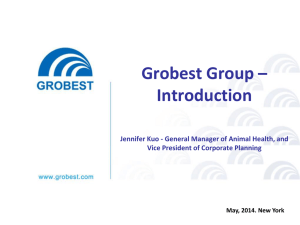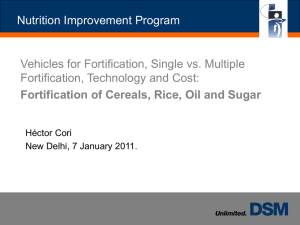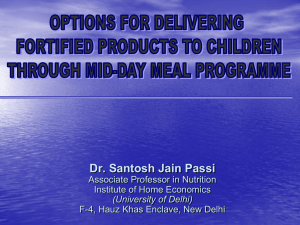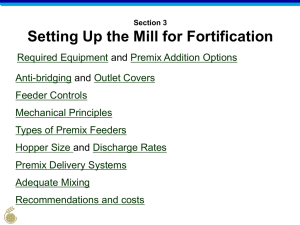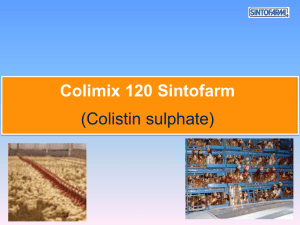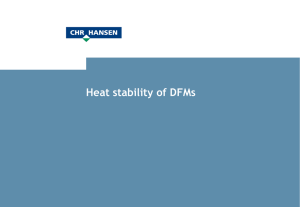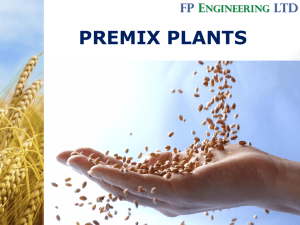Procuring Premix - Food Fortification Initiative
advertisement
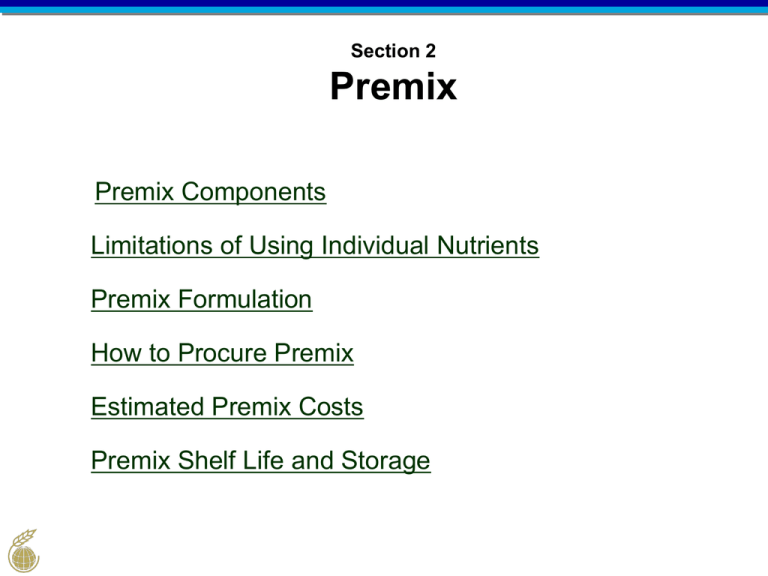
Section 2 Premix Premix Components Limitations of Using Individual Nutrients Premix Formulation How to Procure Premix Estimated Premix Costs Premix Shelf Life and Storage Premix Components The most common flour fortification practice is to add multiple vitamins and minerals using a single ingredient called a premix. Premix includes: • Fortificants (powdered vitamins and minerals) • Excipients (carriers, fillers) • Free-flow agent Premix may have a yellow or green color. This does not affect the color of flour because premix is added in such small amounts. Photo courtesy of Hexagon Nutrition Non-Fortificant Premix Components Excipient: • Lowers premix bulk density to match flour • Improves feeding and blending • Also referred to as carrier or filler • Examples include starch or maltodextrin Free-flow agent: • Keeps the premix from clumping and bridging in the hopper • Examples include tricalcium phosphate or precipitated silica (silicon dioxide) Limitations of Fortifying with Individual Nutrients • Used in very small amounts • Tend to be excessively light or dense compared to flour • Tend to clump • Difficult to feed individually • Requires multiple feeders, checks and adjustments Folic acid, pictured here, is hard to add to flour individually due to the small amounts needed. Recommended addition rates are 1 to 5 parts per million based on the country’s consumption patterns. It is easier to add nutrients in a premix with other vitamins and minerals. Photo by Jeff Gwirtz Premix Benefits • Easier to test • Single feeder, check and adjustment • Easier to feed • Provides uniform nutrient distribution • Single ingredient tracer possible • Less expensive than buying individual nutrients Individual nutrients, such as these pictured, are more difficult to add to flour than a single premix with a blend of the required nutrients. Photo courtesy of WIN, World Initiative for Nutrition, a business unit of Fortitech Premix Formulation Manufacturers select ingredients and formulations based on: • Compound composition • Additive characteristics – Bioavailability – Storage stability – Cost • Targeted premix addition rate Premix manufacturers create premix based on a variety of factors. Photo courtesy of Muehlenchemie GmbH & Co Manufacturer Overages Premix manufacturers usually include nutrients at levels approximately 2% to 5% higher than listed on the label. Premix photo courtesy of Muehlenchemie GmbH & Co This accounts for potential nutrient loss and ensures that the premix meets the label claims. Flour Improvers Flour improvers used in mills may include: Enzymes Oxidants • Alpha Amylase • Azodicarbonamide • Protease • Benzoyl peroxide • Potassium bromate • Ascorbic acid Do not add these materials to the fortification premix in a single feeder. Risks of adding improvers to fortification premix: • Quality is compromised as addition of fortificant should be constant but improver addition rates are adjusted to meet specifications • Shelf life of vitamins may be altered if combined with improvers in a highly concentrated mix in the feeder • Some fortificants can react with benzoyl peroxide and degrade the nutritional value of the premix How to Procure Premix • Establish premix specifications • Develop list of alternate suppliers • Establish an economic order quantity • Conduct annual review of: • Establish internal re-order point considering: - Certificate of Analysis - Pre-mix performance - Lead time - Delivery Time - Inventory - Quality - Production schedule - Price Establish Specifications To Include: 1. Definition Describe the product, source, intended purpose, processing aids 2. Chemical Analysis Moisture, vitamin activity, mineral content 3. Organoleptic qualities Aroma, taste 4. Physical Particle size, density, color, appearance 5. Bacteriological Total plate count, salmonella, staph, aureus, e. coli, yeast, molds Specifications (continued) 6. Mycotoxin Status None should be present 7. Enzyme Activity Alpha-amylase if applicable 8. Functional/Characterization Nutritional improver 9. Packaging and Storage Conditions Package net weight, type and size, label declaration, storage conditions (temperature and RH), shelf stability, length of time in storage 10. Dietary Law Status Target, minimum, and maximum levels and test methods should be identified for each specification as appropriate. Purchasing Department The Mill Purchasing Department keeps the following information about the supplier on file: • Name and address of the supplier’s company or organization • Name and phone number of the principal contact to whom the order should be directed • Name or type of the premix to order (specification) • Standard amount of the premix ordered • Premix price history • Method and time of delivery Premix Supplier Provides: A Product Information Sheet or Fact Sheet including: • Name and intended use of premix • Name and contact information of manufacturer • Ingredient composition of premix – usually in descending order • Food grade status of ingredients (i.e. Food Chemicals Codex (FCC) grade) • Recommended addition rate of premix to flour and levels of micronutrients added at that rate • Certificate of analysis for each lot with: - Minimum assay standards for the premix - Maximum assay standards if any exist • Storage and handling instructions • Allowable storage periods or shelf life of premix Keep this document on file at the mill. Make it available to key operating and quality control personnel. Premix Procurement Options • Order domestically if possible to avoid importing fees • Look for regional or global producers if needed • Purchase from direct private enterprise, representative, or broker • Centralized, cooperative purchasing group such as a local millers association may purchase in bulk for members • Some governments provide premix to all millers in country • Non-governmental agencies may provide premix for a limited time Procurement Alternatives • GAIN Premix Facility: Competitive bids from approved suppliers for a specified premix through an internet bidding system. GAIN is the Global Alliance for Improved Nutrition. See http://gpf.gainhealth.org/ • Some countries, such as South Africa, have created approved premix supplier lists that must be used. See http://www.grainmilling.org.za/ - click Vitamin Suppliers. Please Note: No supplier is endorsed by this toolkit. Potential suppliers should be thoroughly investigated prior to purchasing premix. Estimated Premix Costs Premix US $ per metric ton of flour Iron + folic acid $0.85 - $3.00 Iron, folic acid, other B vitamins $1.60 - $3.90 Iron, folic acid, other B vitamins, vitamin A $2.85 - $9.90 Note: Estimates do not including shipping, import duties and value added tax. Actual costs may vary by as much as 30% and is dependent on manufacturer, location, amount ordered and should NOT be used as official market prices. Cost Reduction Approaches • Pursue government reduction and/or elimination of premix taxes and import fees • Seek price quotes from two or more suppliers to ensure competitive bids. • Follow Economic Order Quantity principles: - Order large quantities as determined by premix shelf life - Commit to purchase premix from a single supplier for a longer contract period Premix Cost in the Supply Chain Fortification costs are minimal throughout the supply chain. Flour millers: • US$1.00 - $4.00 metric ton Bakers and re-processors: • US $0.05 - $0.20 per 50 kilogram of flour Consumers: • < US $0.02 per 5 kilogram bag of four • < US $0.003 per 1.5 kilogram loaf of bread • < US$0.001 for 250 grams pasta Premix Shelf Life • Minerals are particularly stable • Vitamin effectiveness reduced over time • Premixes without vitamin A may keep their nutritional value up to two years • Premixes with vitamin A may only keep their nutritional value for 6 months Notes: Premix manufacturers or distributors do not accept return of premix that has exceeded its shelf life. Shelf life may be further reduced if premix is stored incorrectly at the mill. Premix Storage In the Warehouse: • Readily accessible • Not Exposed to: - Sunlight - Excessive Heat - Moisture - Damage or Theft • First-In-First-Out (FIFO) Above: http://www.flourarranging.com/2010/10/14/wright-out-ofnowhere Below: http://www.dnpint.com/email_newsletter/Ingredient_Times_No82.htm On the Production Floor Segregate premix and improvers by color coding or labeling. Keep one or two working boxes of premix near the feeders for easy access. Multiple feeders installed in a row are known as a feeder bank. Identify each feeder clearly to prevent accidently mixing improvers and premix. Photo courtesy of Research Products More information on Premix • Recommended practices for premix manufacturers: http://www.ffinetwork.org/implement/documents/Premix_Best_Practi ce270408.pdf • Answers to frequently asked questions about wheat flour milling: http://www.ffinetwork.org/about/faq/faq_wheat_industry.html • Code of Practice for Food Premix Operations • Pan American Health Organization of the World Health Organization http://www.who.int/nutrition/publications/micronutrients/92_75_1258 9_9/en/index.html
